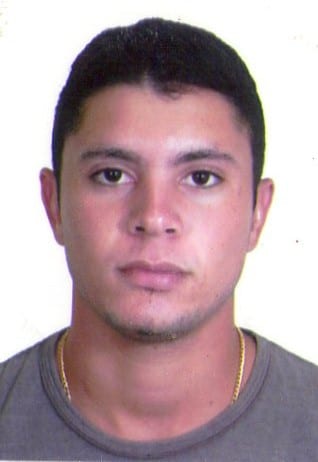ORIGINAL ARTICLE
DIAS JUNIOR, Robson da Silva [1]
DIAS JUNIOR, Robson da Silva. Psychomotor analysis of ‘Tag’ street play as a subsidy to physical education teaching planning. Revista Científica Multidisciplinar Núcleo do Conhecimento. Year 01. Vol. 09. pp. 05-21 October / November 2016. ISSN: 2448- 0959, Access Link: https://www.nucleodoconhecimento.com.br/education/psychomotor-analysis-of-pick-up, DOI: 10.32749/nucleodoconhecimento.com.br/education/psychomotor-analysis-of-pick-up
ABSTRACT
Children in early childhood education are in full acquisition and development of psychomotor skills. Therefore, they need to experiment with various play skills, which promote these acquisitions. And, so, it is necessary to know the psychomotor parameters that are involved therein, with that, you will have your choice in a judicious and intentional way. Therefore, the present research aimed at verifying and analyzing the possible psychomotor parameters to be developed in the street play “tag” as a subsidy to the planning of classes in School Physical Education. This is done by a script of analysis and filming. Therefore, the research found the following results: the game developed 7 motor skills of 35 required; Developed 7 required physical abilities of 23; Developed 2 mnemonic skills of 13 required; Developed 8 required sensory-perceptual skills of 19 required; Developed 12 required perceptual-motor skills of 18; Developed 8 requisite socio-affective skills of 15. Thus, it was possible to conclude that the street play “tag” develops in children who play the game with certain skills of each area analyzed. In this sense, the Physical Education teacher can propose goals that he wants to achieve according to the psychomotor parameters that develop from him.
Keywords: Development, Motor, Children, Rules games.
INTRODUCTION
According to Gallahue; Ozmun (2005) motor development can be divided by phases and stages, starting in the reflex phase (pre and postnatal), stage of coding and decoding; Rudimentary phase (1 to 2 years), stage of inhibition of reflexes and pre-control; Fundamental phase (2 to 7 years), initial stage, elementary and mature; Specialized stage (7 to 14 years onwards), transitional stage, application and permanent.
The same authors say that from the fundamental motor phase the stages present their peculiarity of locomotion (running and jumping), stabilization (balance in one foot only) and manipulation (throwing and catching). It is a process of learning to move with control and competence, caused by individual, environmental and physical factors. Therefore, movement becomes an applicable tool for acquiring the complex motor skills present in daily life, recreation, and in sports games. Therefore, motor skills need to be well stimulated in order to reach refinement, combination and elaboration in the fundamental phase, because the appearance and extension of movement development depends on the proposed challenges, the individual act and the environment, which will influence the Motor behavior.
According to Miller (1968, apud Gallahue; Ozmun, 2005) observed in children between 3 and 5 years who receive instructions more easily in learning fundamental motor skills. This shows us that bringing them to practice per instruction can increase the motor pattern beyond the level reached only by having matured.
Thus, age influences the appearance of certain abilities, especially in early infancy, but does not depend on it to have motor proficiency in the practice of activities or exercises (GALLAHUE; OZMUN, 2005).
From this point of view it is essential to observe what Willrich; Azevedo; Fernandes (2009, p.52) informs us:
[…] inicialmente, acreditava-se que as mudanças no comportamento motor refletiam diretamente das alterações maturacionais do sistema nervoso central. Hoje, porém, sabe-se que o processo de desenvolvimento ocorre de maneira dinâmica e é suscetível a ser moldado a partir de inúmeros estímulos externos. A interação entre aspectos relativos ao indivíduo, como suas características físicas e estruturais, ao ambiente em que está inserido e à tarefa a ser aprendida são determinantes na aquisição e refinamento das diferentes habilidades motoras.
According to Gallahue; Ozmun (2005) perceptual-motor development presents its evolution in the voluntary motor act, since every voluntary movement involves an element of consciousness, that is, the perception results from a sensory-perceptual stimulus. But the development of an individual’s perceptual abilities depends, in part, on the required task or motoring act. Therefore, all voluntary movements involve the use of one or more sensory modalities, to a greater or lesser extent and the more perceptive-motor activities are required, the greater is the degree of accommodation with information already stored, with this greater proficiency in the motor gesture. Thus, the more motor-perceptual-motor experiences involving children, the greater the perceptual-motor combinations and the development of reactivity plasticity.
The same authors report that when children undergoing motor tasks are also developing their physical abilities. There is an interrelationship, because if a motor task is performed repeatedly, such as bouncing a basketball, muscular endurance is required, so if there is a faster pace, using the race plus the manipulation of the basketball, they will be involved Cardiovascular endurance and flexibility. So the physical components are linked to motor skills. Therefore, subjecting children to motor tasks is contributing to their motor control and quality of life.
They also mention that the socio-affective aspect are feelings and emotions that are involved in interpersonal relationships, when applied to the individual and to others through movement.
We can observe in the study of Ferreira (2007) where he reports on socio-affective development. By saying that children when they are playing experience various situations, positive and negative that through these situations they seek their social coexistence.
The development of memory skills needs to be stimulated through repetitive stimuli. According to Fonseca (1995), all learning puts into play a certain type of memory, that is, information preserved, assimilated, from previous experiences that unite with new ones, so that the individual does not have to return to its initial stage. This reduces the wrong answers until you find the right one.
Memory is a functional and inter-hemispheric system (storage and preservation of information in both hemispheres) that affects learning, especially short-term learning. Therefore, memory should be stimulated dynamically and not mechanically, put in place, because it seems to be proven that the trainability facilitates learning. Therefore, memory is the basis of reasoning, that is, if there is no storage, there is no learning (FONSECA, 1995).
Many of the games and games that children play these days can be found in figure 1, called “children’s play”. This painting was painted by the Dutch artist, Pieter Bruegel, around the year 1560.
Figure 1.
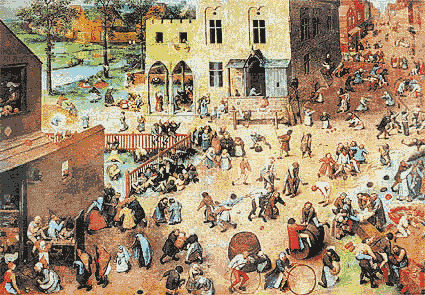
ORROCKS, A. Homo ludens: Pieter Bruegel’s Children’s Games and the Humanist Educators’. Journal of Historians of Netherlandish Art, 2012.
Given this, street play is part of history in our society and has been practiced since colonial times in several places in Brazil. Brought by the Portuguese, Indians and slaves. Soon, we know that games and games change from region to region, as Darido says; Rangel (2005, p.158).
[…] as brincadeiras costumam variar conforme a região, mas mantêm sua essência, sua forma e sua poesia. O aspecto que mais se altera é a letra das canções e o próprio nome dos jogos. Aliás, no Brasil, há uma riqueza muito grande de jogos e brincadeiras, uma vez que os herdamos dos portugueses, índios e negros numa quantidade incrível.
Faced with this fact, we can understand the origin of street play “tag”, which is well known here in Brazil, but in relation to its name varies by region. An example of this is finding the joke in the city of Belém-PA as a “pira“.
According to Silva et al. Al. (2012, p. 34) say that the “piras (a large set of games equivalent to what is called tag in the Southeast Region of Brazil)”.
The same author categorized the game into rules games.
According to Piaget (1978, p. 148) “the rule is a regularity imposed by the group, in such a way that its violation represents a fault.”
The same author says that the children organize themselves, leave the individual and pass to the social. Therefore, the games need the interaction between them and there are changes of ideas and arguments for or against. This implies learning rules and behaviors, where children build bonds for their adult lives.
Therefore, the traditional games of (streets) are passed down from generation to generation preserving children’s culture and developing in them forms of social coexistence. The games are free and the children seek the game for the pleasure of doing it, with an end in itself and fully fulfills the need to play or play (PONTES; MAGALHÃES, 2003).
Children from 4/5 years of age already begin to play the rules games, such as, pira or “tag” (SILVA et al., 2012).
This information gives us insights to understand that in the elementary stage of the fundamental motor phase children who are 4/5 years play the game (GALLAHUE; OZMUN, 2005).
According to the designations of the law of guidelines and bases of national education, Law No. 9,394 (BRAZIL, 1996), infant education, being the first stage of basic education, aims at the integral development of children up to six years of age in their Physical, psychological, intellectual and social aspects. Complementing the action of the family and community, thus, supporting the inclusion of the child in society with morality, character and personality.
Therefore, children enrolled in pre-school, aged between 4 and 5 years, have the opportunity to practice, in physical education classes, various motor tasks, which can simultaneously involve all the aspects mentioned above. Therefore, they may be street plays, in the case of “tag”, experienced by them or not. In this case, the classes represent the environment that, too, will generate learning and development in children.
What does it mean to say that if there is in the pre-school physical education classes the “tag” play can occur the development of skills.
Such information becomes clear in Freire’s (2006) position to say that this play involves cognition because it further develops the spatial notions developed by them at the time of escape and persecution. This also implies the development of their own motor and physical resources. In addition to the energetic mechanism used in the task, if the efforts are of high intensity, anaerobic metabolism prevails. In addition to the interpersonal relationships that develop from her.
The same author describes the most traditional way of practicing this game, is choosing a catcher that will try to catch the other children, within a limited space, the one that is caught will become the catcher of the time and so on.
We can observe what Gallahue; Ozmun (2005, p.22) says of the joke: “A child who participates in a simple tag game, which requires running and shunting in all directions, never uses exactly the same movement patterns during play.”
Also involved are physical and motor vigor, as described by Cordazzo; Vieira (2008, p.372) “Some examples of games that stimulate the physical and motor development can be: chase, seek and catch games”.
This type of (traditional) rule play has had a positive repercussion in several skills, which according to Pereira (2015) in his research on teachers’ perception of traditional street games “tag” and others in the school space as a resource for the Pre-school children, all teachers questioned answered in the affirmative. Mentioning that these games develop motor coordination, reasoning, orality, memorization, attention and balance. Also highlight, when the child plays, learns. And, they emphasize learning in compliance with norms and rules in situations of mistakes, losses and the patience in waiting for the turn.
Faced with this, the teacher in Infant Education in the teaching of Physical Education establishes means to develop the psychomotor aspects in the students, through the diversity and complexity of movements using the joke. But be aware of the types of activities imposed, because it is not enough to offer activities without having an analysis of it. With this, choosing activities improper for the purpose proposed.
From this point of view, such information is echoed in Rocha’s position; Lily (2010) observing the child playing as a practice of school physical activity without at least having any theoretical foundation is difficult to understand what happens when they play. Therefore, it is clear that the teacher should analyze all his activities and jokes with the intention of putting together a careful planning.
According to Antunes (2002, p.37) “never think of using pedagogical games without careful and careful planning, marking in very clear steps and effectively accompanying students’ progress.”
Therefore, we can find repercussions on the use of the game “tag”, which according to Freire (2006, p.142) says that “using a child’s game, as a catcher, among the contents of a Physical Education program, only does meaning if the teacher can understand the meaning of this toy in an educational situation”.
Thus, this analysis of the game considered to be a shortage of literature that justifies the accomplishment of this research, therefore, aimed to verify and analyze the possible psychomotor parameters to be developed in the street play “tag” as a subsidy to the planning of classes in School Physical Education.
The present study is relevant because it enriches the methodological collection of the professionals of the area, orienting them in a judicious choice of play as a pedagogically elaborated activity.
MATERIAL AND METHODS
The research sought to check the children’s action by playing tag and analyze it with a game / play activity script to describe what and how many skills are involved in the play. To classify the research it was necessary to consult Gil (2008). Classifying in: as regards the purposes, in descriptive and when to the means, of field.
In order to collect data, a request was first made to the director by the author of the study, who is also an intern of the institution, which is located in the neighborhood of Praça Seca, RJ, located at Rua Santa Genoveva N ° 250. There was no obstacle on the part of the director, Physical Education teacher, giving total freedom and support.
The data collection was carried out in the sports court of a school with dimensions of 20m x 17m, free of any obstacle, on 04/04/2016, around 8:00 AM, when the children practice Physical Education. The subjects of the research were 09 children between 04 and 05 years of preschool of both sexes, who were guided by the author of the work to carry out the “tag” play. 03 children were marked with an orange vest before starting the activity, doing this, purposely, to focus on the catching students of the fugitives. Soon, there were exchanges after a certain time of whoever picks whom to escape to have an analysis of all the pickers. As a result, the activity lasted 25 minutes of practice, 5 minutes apart at the request of the students.
An adapted script was used as an instrument for the analysis of the games or games, as there was a reorganization in withdrawing and adding other skills in the motor, physical, mnemonic, sensory, perceptive-motor and socio-affective areas. Created by (DA SILVA; EMMEL, 2008). To use this instrument the teacher should observe the children playing or playing and marking with one (x) the skills developed.
In order to aid in the analysis of the game, two Intelbras VM 1120IR camcorders were used to monitor the school, which are fixed in a previously established place that can visualize all the space to be filmed, thus preventing children from feeling Intimidated or attracted to them.
A video operator, a school official, authorized by the principal provided the video on a Pen Drive containing the actions of the children during the play, through which the cameras were identified from (C1) and (C2), to facilitate observation and Skills analysis. Thus, the author will have greater convenience in analyzing and comparing the video with script used by him, as many times as necessary, this shows greater reliability in the research.
Thus, the TAO (Term of Authorship and Originality) was used as research ethics.
RESULT AND DISCUSSION
We present below the results of the “tag” play in the areas of: motor skills, physical abilities, mnemonic skills, sensory-perceptual abilities, perceptual-motor skills and socio-affective skills. To define the different possible skills to be developed in the activity. Due to the scarcity of literature there was a restricted discussion related to play and its application as curriculum content in Physical Education.
The use of the script to analyze games and games allows identifying the predominance of areas in the use of street play. However, we must consider the amount of subitems in each area for a reliable analysis, ie if an area has an item (x) and this item has 5 subitems, step count only the subitems and not the item.
The motor area, which has 35 abilities distributed in locomotion – walking, running, jumping, jumping (in distance, in height, of a certain height, with obstacle) skipping, mixed jumping, galloping / To go up / down, to crawl, to crawl. manipulation – receive an object through the air, trim an object, volley an object, pass an object, pick an object, bounce an object by air or soil, bounce an object, throw an object, kick an object In air or soil, stabilizing, maintaining balance by performing axial movements, inverted support, rotating, deflecting, pulling, pushing, turning, raising / stopping and fine motor skills (Digital grasp, palmar, palmar against the ground, in digital tweezers, fine manual-manual coordination). The game developed the following motor skills: walking, running, galloping / sliding, raising / sitting / stopping, deflecting, turning, axial movements. Therefore, the area of motor skill reached approximately 20% (percent), developing 7 of the 35 required skills, as can be observed in figure 1.
Figure 2 – Motor skill Area.
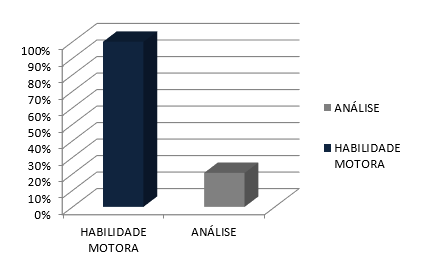
The physical area, which has 23 required capacities, distributed in: Strength : dynamic, static, Speed : reaction, limb movement, Strong, Flexibility : static, dynamic, Balance : static, dynamic, recovered. Resistance : muscular localized, aerobic, anaerobic, Power , Coordination: manual oculus, pedal, manual-pedal oculus, viso-motor, , MMSS and Muscular aspect: rudimentary, refined. Developed the speed of reaction, limb movement, displacement, agility, anaerobic resistance, rudimentary muscular aspect and coordination. Therefore, the physical capacity area reached approximately 30.43% (percent) 7 of the 23 required capacities, as can be observed in figure 2.
Figure 3 – Area of physical capacity.
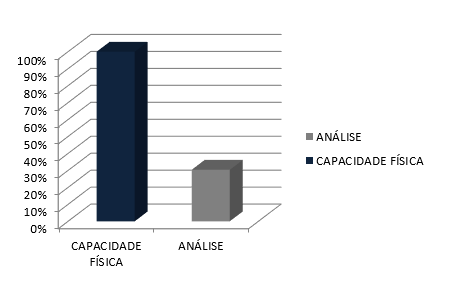
The mnemonic area, which has 13 required skills, distributed in: Visual memory: recall of previously viewed activities, combinations of equal, newly viewed figures. Auditory memory: reproduction of sounds: of animals, of the environment, of people, reproduction of newly listened sounds, telling stories, remembering names: beings, rules. Sequential memory: repeat numbers or phrases, digit in order. Memory viso motor: imitate beings, situations, positions, gestures recently seen. He developed visual memory (recall of activities) and auditory memory (remember names and rules). Therefore, the mnemonic area reached approximately 15.38% (2) of the 13 required skills, as can be observed in figure 3.
Figure 4 – Mnemonic skill area.
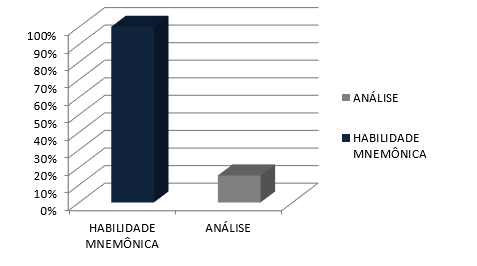
The sensory-perceptual area, which has 19 required skills, distributed in: Visual perception : perception of figures, objects, people, colors, perception of the same or different forms, perception of accompaniment and fixation, perception Figure background, perception of geometric figures, peripheral vision, distance perception, dynamic and static perception of objects or people. Auditory perception : differentiate sounds, distinguish intensity, locate direction, listen for call by name. Tactile Perception : identify objects: (rough, smooth, soft, hard), shapes and sizes, temperature, people. Attention : aimed at people and objects. Kinesthetic perception . Developed the perception of colors and people, dynamic and static perception of people, called by name, tactile discrimination in people and attention directed to people, peripheral vision, perception of distance, perception of accompaniment and fixation. Therefore, the sensory-perceptual area reached approximately 42.10% (8%) of the 19 required skills, as can be observed in Figure 4.
Figure 5 – Sensory-perceptive skill area.
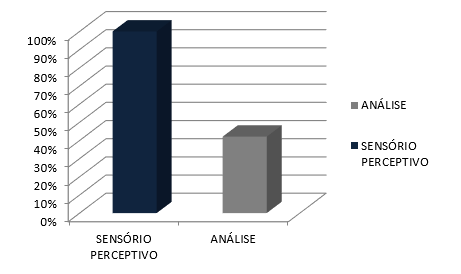
The perceptual-motor area, which has 18 required abilities, distributed in: Body perception : self-identification, localizing the parts of the body in itself or in others, functionality of parts of the body, Body, body parts perception in movement, body expression (joy, sadness, tiredness), Directional perception : up / down, forward / backward, right / left, inside Outside. Perception of laterality : manual, ocular, pedal. Spatial perception : ability to project the body into space, perception of how much space the body occupies. Temporal Perception : synchrony of movements, perception of cadence, sequence of movements. Self-identification, functionality of body parts, perception of body parts in movement, body expression, directional perception (front / back, right / left, middle / around), manual laterality, cadence perception, sequence of movements and perception Space. Therefore, the perceptual-motor area reached approximately 66.66% (percent) of the 18 required skills, as can be observed in figure 5.
Figure 6 – Perceptual-motor skill area.
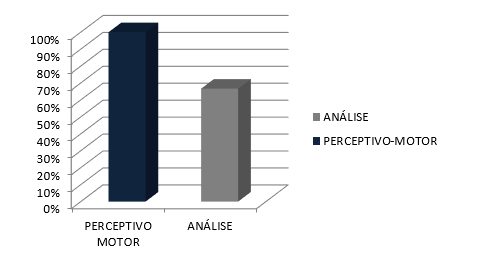
The socio-affective area, which has 15 required skills, distributed in: Communication , Contact , Individuality , Solidarity Inclusion , Cooperation , Collectivity , Verbalization , Integration , Social Maturity , Motivation and Pleasure . In the item contact has 2 subitems (people and objects), in the item maturity has 2 subitem (assume responsibility and independence). In the item verbalization has 2 subitem (obey orders and verbal expression). He developed communication, contact with people, verbal expression, obedience to orders, integration, motivation, pleasure and social maturity (Independence). Therefore, the socio-affective area reached approximately 53.33% (percent) of the 15 required skills, as can be observed in figure 6.
Figure 7 – Socio-affective skill area.
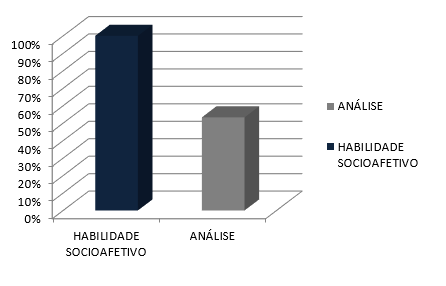
The data in table 7 present, in percentages, the reached level of the areas: motor, mnemonic, physical, sensory-perceptive, perceptive-motor and affective partner that predominated in the game “handle” according to the quantity of items and subitems By area, as can be observed in figure 7.
Figure 8 – Comparison of the analyzed areas
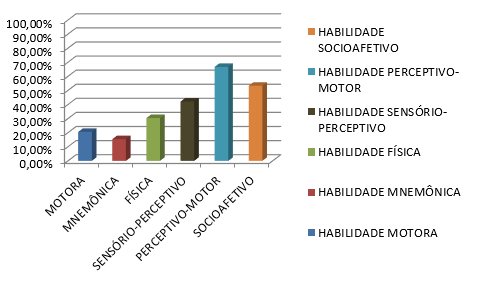
The present result showed that the “tag” play developed 44 skills, added, by the 6 areas analyzed. Given this, the research shows in detail the skills described by (GALLAHUE; OZMUN, 2005); (Freire, 2006), (PEREIRA, 2015); (CORDAZZO and VIEIRA, 2008) in their respective areas analyzed and others not mentioned. This facilitates the Physical Education teacher in proposing his goals in the planning assembly and choosing the game in a judicious and intentional way. The comparison of the areas analyzed was according to the quantity of items and subitems for each analyzed area. Therefore, the “tag” game predominated in the perceptual-motor area, which reached 66% (percent).
CONCLUSIONS AND RECOMMENDATIONS
The study leads to the conclusion that the street play “tag” develops in children who practice play certain skills of each area analyzed. Thus, an instrument for learning, which can be used in a planned way, is an activity that contributes to the acquisition and development of children’s psychomotor skills and to their quality of life and social well-being, Refinement of motor skills with movements purely rescued from the street. With this, showing habits of an active lifestyle in a motivating and pleasurable way, therefore, being easy to apply and does not require expenses and material resources. In addition to establishing means to comply with rules, which may influence life in the exercise of citizenship and social inclusion.
Therefore, in face of what was researched, it is recommended to Physical Education professionals that the areas allow to analyze various games and games. From this analysis, it is up to the teacher to propose objectives that he wants to achieve according to the psychomotor parameters that develop from him. Thus, assisting you in assembling your planning. Therefore, having a careful and intentional choice of the activity analyzed.
Therefore, this research had limitations due to having a joke only analyzed by the time and complexity of the research in relation to the strategies and technologies required to collect the data with image registration.
REFERENCES
ANTUNES, Celso. New ways to teach, new ways to learn . ARTMED, 2002.
BRASIL, LDB et al. Al . Law No. 9,394, of December 20, 1996. Establishes the guidelines and foundations of national education , 1996.
CORDAZZO, Scheila Tatiana Duarte; VIEIRA, Mauro Luís Characterization of children’s school play. Psychology: Reflection and Criticism , v. 21, n. 3, p. 365-373, 2008.
DA SILVA, Carla Cliene Baptista; EMMEL, Maria Luisa Guillaumon. GAMES AND JOKES: ROTARY OF ANALYSIS OF ACTIVITIES FOR THE OCCUPATIONAL THERAPIST. UFSCar Occupational Therapy Notebooks , v. 4, n. 1 & amp; 2, 2008.
DARIDO, S. D. and RANGEL, I. C. A. Physical Education in school: implications for pedagogical practice. Rio de Janeiro : Guanabara Koogan, 2005.
FREIRE, John the Baptist. Full-body education. São Paulo: Scipione , v. 4, 2006.
FERREIRA, Heraldo Simões. The formation of moral conscience in the child. Readings: Physical Education and Sports , n. 104, p. 4, 2007.
FONSECA, V. Introduction to learning difficulties. 3ªed. Porto Alegre: Medical Arts, 1995.
GALLAHUE, D. L .; OZMUN, J. C. Understanding Moto Development r. 3rd edition. Sao Paulo. Phorte, 2005.
GIL, Antonio Carlos. How to design research projects . 4. ed. São Paulo: Atlas, 2008.
ORROCKS, A. Homo ludens: Pieter Bruegel’s Children’s Games and the Humanist Educators’. Journal of Historians of Netherlandish Art , 2012.
PONTES, Fernando Augusto Ramos; MAGALHÃES, Celina Maria Colino. The transmission of the culture of the joke: some possibilities of investigation. Psychology: reflection and criticism , v. 16, n. 1, p. 117-124, 2003.
PEREIRA, Monissa Juliana. Perceptions of children, families and teachers on traditional street games in school, as a resource for pre-school children’s development , 2015.
Piaget, J. Symbol formation in children . Rio de Janeiro, Zahar, 1978.
ROCHA, Fioravante; LÍRIO, Luciene Ribeiro. Relational psychomotricity and its intervention in Early Childhood Education. Readings: Physical education and sports, n. 147, 2010.
SILVA, Sarah Danielle Baia et al. Street jokes in Belém-PA: an analysis of gender and age. Psychology: theory and practice , v. 14, n. 2, p. 28-42, 2012.
WILLRICH, Aline; AZEVEDO, Camila Cavalcanti Fatturi de; FERNANDES, Juliana Oppitz. Child motor development: influence of risk factors and intervention programs. Rev Neurocienc , v. 17, n. 1, p. 51-6, 2009.
[1] Graduating in Physical Education – Faculdade Estácio
